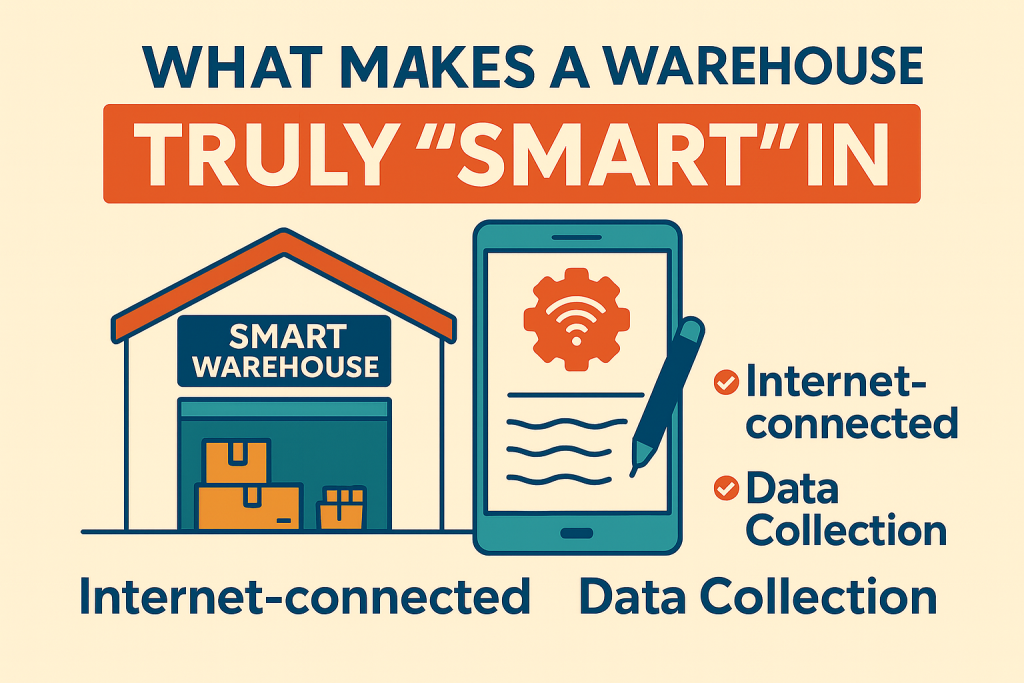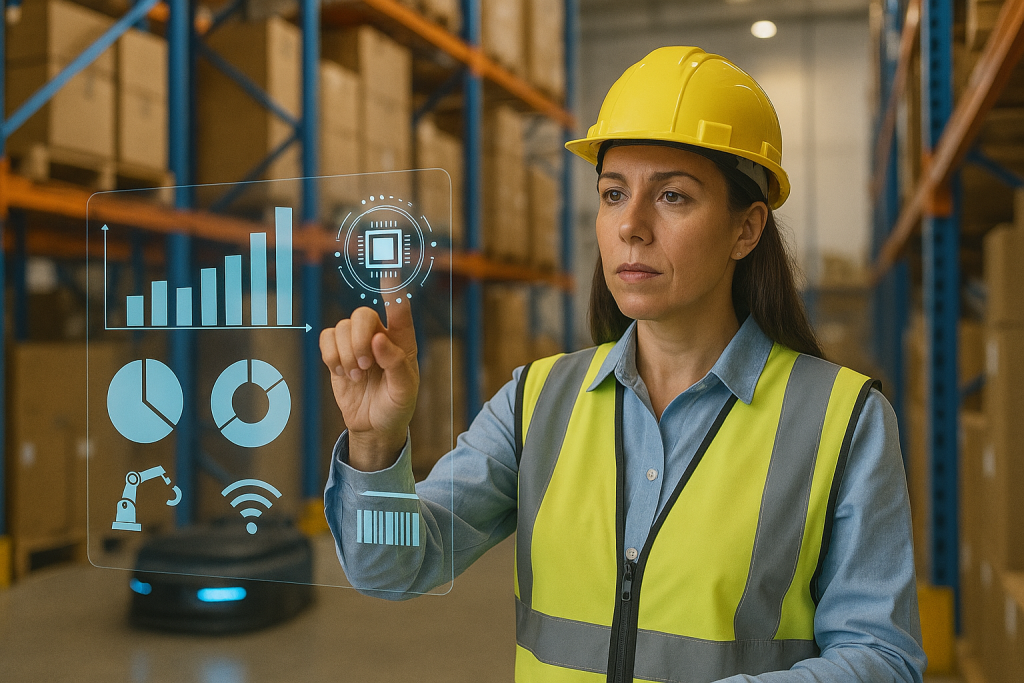By Martin Vassilev / 14 Aug, 2025

In 2026, “smart” warehousing has evolved beyond simple automation and barcode scanning. Modern facilities are powered by a fusion of artificial intelligence, real-time data analytics, autonomous robotics, IoT-enabled infrastructure, and predictive inventory control. This combination doesn’t just improve efficiency — it fundamentally redefines how goods are stored, moved, and delivered. The future of logistics belongs to warehouses that can adapt dynamically, predict demand before it happens, and operate with minimal human intervention while maintaining high accuracy and cost control.
Artificial Intelligence (AI) is no longer an optional enhancement — it’s the operational brain of a smart warehouse. From predicting inventory needs to dynamically assigning pick paths for robots, AI ensures every decision is rooted in real-time data. In fact, according to recent logistics AI insights, AI adoption has accelerated order accuracy rates by over 30% in advanced facilities.
Internet of Things (IoT) devices embedded across shelving units, pallets, and vehicles provide constant status updates. These sensors detect environmental conditions, track item locations, and send alerts when anomalies occur, ensuring high-value or temperature-sensitive goods are monitored 24/7.
Robotic arms, autonomous mobile robots (AMRs), and drone-based inventory checks are now commonplace. These machines handle repetitive tasks faster than humans while reducing labor costs and safety risks. Modern robotic systems are also self-learning, meaning they adapt to seasonal changes or new product lines without reprogramming.
Gone are the days of reactive restocking. Smart warehouses in 2026 use predictive algorithms to anticipate demand fluctuations weeks in advance. By integrating historical sales data, market trends, and even weather forecasts, facilities can reduce stockouts and overstock situations by up to 40%.
Companies leveraging data-driven inventory systems not only cut costs but also ensure customer satisfaction through faster fulfillment.
A truly smart warehouse is not an isolated hub — it’s a synchronized node in a global logistics network. APIs and blockchain-enabled records provide transparent, real-time communication between suppliers, distributors, and transportation providers. This ensures that any change in demand, delay, or disruption is instantly visible across the chain.
For example, integrating with platforms like real-time warehouse tracking systems allows managers to monitor inventory movement from supplier dock to customer doorstep.
Sustainability is no longer a branding perk — it’s a business imperative. In 2026, warehouses are designed for energy efficiency with:
Solar-powered roofs and battery storage
Automated climate control to reduce waste
AI-optimized routing to cut unnecessary movement and energy usage
Sustainable packaging automation to minimize material waste
Facilities adopting green logistics strategies not only lower operating costs but also meet increasingly strict environmental regulations, similar to the guidelines found on Government of Canada’s sustainable business resource.
Digital twins create a virtual replica of the warehouse, allowing managers to test operational changes without physical disruption. Whether rearranging storage zones or introducing new machinery, simulations help optimize without costly trial and error.
These systems analyze order patterns and route picking robots through the most efficient paths, dramatically reducing fulfillment times.
Immutable ledgers prevent disputes over shipping times, quantities, and product conditions — essential for high-value supply chains.
These forklifts navigate complex layouts, avoiding obstacles and working alongside human employees without risk.
For industries like pharmaceuticals or perishables, smart warehouses deploy precision-controlled storage areas monitored in real-time to meet strict compliance standards.
In an era of one-day and same-day delivery expectations, smart warehouses play a pivotal role in brand reputation. Advanced facilities can:
Provide customers with real-time tracking updates
Offer precise delivery time windows
Reduce returns with error-free picking systems
Brands that implement these solutions, as shown in how smart warehousing improves delivery times, often see repeat purchase rates soar.

Smart warehouses are fortified with more than physical locks and guards. AI-based video analytics detect unusual patterns, IoT locks secure sensitive goods, and cybersecurity measures protect operational networks from hacking attempts. As more systems connect via the cloud, cyber resilience is as important as physical security.
Assess Current Infrastructure – Identify automation gaps, network readiness, and IoT compatibility.
Adopt Modular Upgrades – Implement robotics, AI analytics, and IoT sensors incrementally for smoother integration.
Train Workforce for Tech Management – Upskill employees to oversee smart systems, not just manual tasks.
Integrate with Supply Chain Partners – Use standardized APIs and real-time data sharing.
Monitor ROI and Efficiency Gains – Use KPIs like order accuracy, cycle time, and space utilization to track success.
For a deeper look at optimizing warehouse operations, explore future warehouse automation strategies.
In 2026, a smart warehouse is defined by its ability to predict, adapt, and optimize continuously. Businesses that embrace AI-driven operations, autonomous robotics, and real-time transparency will not just compete — they’ll dominate. The difference between thriving and falling behind lies in adopting these innovations now, before they become baseline expectations across every supply chain.

“Thanks to Byexpress all my shipping and fulfillment costs are in line now”

“All my issues were solved by Byexpress team that I had with pervious 3pl provider.”

“Thank you Byexpress team could not done it without you guys.”

“Their integration and customer service were the key for me”

“Outstanding delivery service! The package was well-packaged, and
the delivery team was professional and courteous”

“Great and knowledgeable team to work with.”

Thanks, guys, for reducing my shipping rates
Ottawa Office
2411 Holly Lane
Ottawa, ON, K1V 7P2
Toronto Office
13-280 West Beaver Creek Road Unit #136
Richmond Hill, ON, L4B 3Z1
Alexandria Office
173 Kenyon Street West
Alexandria, ON, K0C 1A0
Montreal Office
4388 Saint-Denis Street Unit #200
Montreal, QC, H2J 2L1
California Office
155 North Riverview Drive
Anaheim Hills, CA, 92808
Call Us
Toll-Free: 1-866-744-7122
Local : 613-739-3000
Email Us
Multilingual Services










